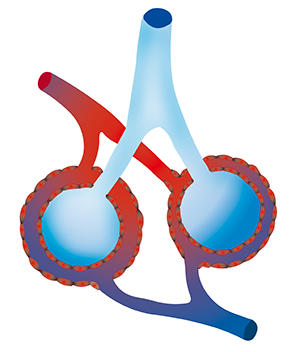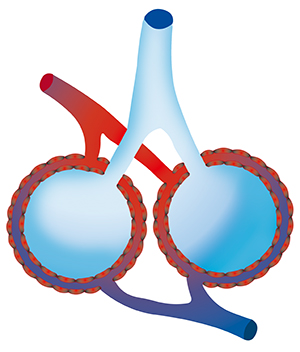Improve your Lung Function
COPD and Chronic bronchitis: Improve your lung function with new approaches and new therapies
Can lung cells regenerate, can lung function be improved?
In every second of our lives, 10 million new cells are formed in the body and as many old, defective cells are broken down and recycled. This happens continually and unconsciously, without our active participation. These processes are automatically controlled and regulated by the body, including those in the lung cells.
The body has many possibilities to compensate for functional disturbances and to repair damage. But doing so requires that certain prerequisites be met.
Essential prerequisites for this are:
- Cease the lifestyle that led to the lung damage
- Help your body to eliminate more deposits and pollutants
- Drink uncontaminated, pollutant-free water in order to bind and eliminate the pollutants in the body
- Give the body the nutrients it needs to build healthy cells
- Strengthen and support your body with biologically sensible therapies
The success achieved through therapy and/or changes in lifestyle habits can be measured quickly and reliably by, for example, recording the heart rate variability (HRV). The scientific basis of HRV measurement is the ECG technique, which is recognized worldwide. HRV measurements allow us to draw direct conclusions concerning the state of the autonomic nervous system (ANS), the body’s top-level control centre. The ANS processes information and stimuli from the psyche and from the nervous, immune and hormonal systems. Disturbed processes within these systems are visibly reflected in HRV measurements.
In people suffering from COPD, the adaptive and regulatory capacity of the autonomic nervous system is clearly disturbed.
Ultimately, this leads to a state in which the lung cells are not properly “controlled” by the ANS. Regeneration and repair processes cannot take place effectively, which in the long run leads to further disturbances and functional limitations. In addition, the widening or narrowing of the bronchial tubes is necessarily hyperinflated by medication, which in the long run leads to even more problems.
Example:
In an acute stress situation (fleeing reaction = overactive sympathetic), the alveoli are automatically hyperinflated/dilated, with the biological sense that even more oxygen can be absorbed for an increased energy production to ward off the danger. If a person is in a state of constant stress, regardless of whether the cause is physical or mental, the alveoli will be permanently hyperinflated, which is then manifested as emphysema. The right therapy now would be to reduce the stress factors in order to reduce the hyperinflation and the most important therapeutic measure would be to strengthen the parasympathetic nervous system through rest and regeneration. This can be measurably achieved by applying oxygen energy therapy, but should also be supported and combined by other measures.

Alveolus, normal state

Alveolus over-inflated, in a state of stress
Oxygen Energy Therapy (SET) has immediate effects:
External Respiration = transfer of oxygen from the air to the lungs and into the blood is called external respiration
Internal Respiration = combustion/utilization of oxygen in the mitochondria, the mini-power plants in our cells. By “burning” oxygen, energy is converted into adenosine triphosphate (ATP), the energy storage molecule of our cells
More energy (ATP) in the cells means more power, clean combustion and hence fewer free radicals, which in turn means less damage to cell structures, faster recovery, more effective adaptation to different conditions and faster regeneration. The current COPD therapy that relies on highly concentrated oxygen can only improve external respiration, but unavoidably results in further damage to the lung cells due to the increased production of free radicals. This is the downside of medical oxygen when it is inhaled in high concentrations for extended periods.
Note: Ionized oxygen is by definition an oxygen radical = free radical!
Oxygen concentrators often ionize oxygen, the argument being that ionized oxygen enters the blood faster and more efficiently – something that from a physiological, chemical or physical point of view simply cannot be.
